Goblinville Gazette #1 by mllaneza
Goblinville Gazette #1
Original SA post Goblinville Gazette #1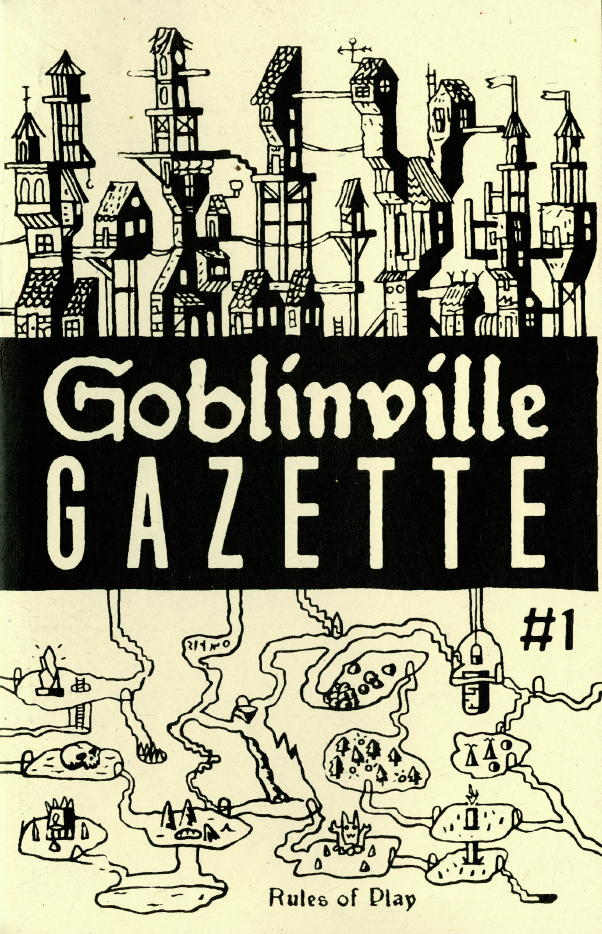
Earlier this year Kickstarter did a big push for zine format RPGs. Small size format, short books, and as much inspiration as the creator can squeeze in. This project was a smash success and lots of clever little games got funded.
Today I’m going to start in on a clever little game about clever little creatures: Goblinville. Physically, this is a 32-page booklet, sharply laid out, and filled with cute illustrations. I'm adopting the book's style and bolding important game terms when they are introduced.
You'll also want the accompanying PDF which has a blank character sheet, a character creation cheat sheet, an adventure tracker, a record sheet for the town, and a blank hex map with a summary of the overland travel rules.
One of the reasons I'm as happy as I am with Goblinville is that it shows a clear line of descent from OD&D, marching order, turns, tracking torches and all that old school goodness. It also has a lot of modern concepts like starting with a blank map, the players' occupations literally define the starting state of the town, how narrative the rules are despite a clear structure to play, and an explicit emphasis on fail forward.
The rule book starts with a page of introduction, what you need to play, and how to setup for the first session.
"Goblinville is a fantasy adventure role playing game about broke goblins and the town they live in..... Their job is to venture forth into the wilds and see if they survive." Their sales copy has it as "...broke goblins traveling to dangerous and fantastical places to find treasure and make rent."
That's the gist of the introduction, and it's a good statement of what the game is all about.
What you need is 3-5 players, a Goblin Master, pencils, dice, and snacks. Dice are important in Goblinville! You'll need a d20 and a lot of d6. Most importantly, every player will need a unique die to use as their action die. Everyone will share a sorcery die, which is recommended to be "weird". And then a pool of 5 or 6 matching dice in case you get to roll extra dice.
The first session will start with character creation. As we will see, character creation is pretty light mechanically, the real meat is in asking the other players about their goblins, and filling in details conversationally. The GM is supposed to be listening and taking notes on what the players find interesting about the characters.
The GM will also be filling in the town sheet based on character occupations and making a start on filling in the blank map. Where Dungeon World starts with a blank map and puts the party and their first dungeon in the center, Goblinville starts with the community in the center of the map. This is the game emphasizing its main theme again.
Lastly, the GM will need to come up with an opportunity for the party, some chance for a score. I recommend thinking of this as a low-level heist game; the PCs aren't notably competent or powerful, but they are determined and clever. Ocean's 11 with sharp sticks and broken bottles. Once the players are sold on the idea, play proceeds.
Turning the page, we get the eight pages of actual rules. The first three are mechanics, then we get rules for making camp, monsters, travel, sorcery (knowing a spell is free, but they're barely cantrips), damage and dying, and the end of session rules.
The first of the mechanics is the marching order. At the start of an adventure the goblins roll initiative with their unique die, and place them on the marching order track from high to low. This isn't a strict order of play, but the current "leader" is first into trouble and is who the GM asks what the party does if it's ambiguous. When a goblin does something risky, they take their Action die out of the marching order. Once all of the action dice have been used, the turn ends and the players will roll initiative again for the next turn.
Turns are very important structurally. Torches only last for two turns, and the party has to camp after every fourth turn. Being in the dark is a bad position, and skipping camping costs everyone a condition.
After marching order and turns comes Positioning & Effectiveness. Position is shared by the goblins and will be good, bad, or standard. As a group, the party shares the stakes. For example, when running from a giant spider, the goblins hide among stalagmites. The GM sets the position to good without requiring a roll. When running from a swarm of bats, the goblins stumble upon a group of human guards, bigger and better armed. The GM sets the position right down to bad.
Effectiveness influences position. Action outcomes can be success, progress, or failure. Progress won't get you out of a bad position, but it will improve a standard position, and counts as a success in good position. Failure sets the party back from a good or standard position, and puts a goblin down in a bad position. In combat, a success inflicts harm, and an extra harm if the goblins are in a good position.
A player makes an action roll when they try to succeed at something risky. They roll a dice pool that starts with their action die from the marching order. The GM says what the danger is, possibly drawing on a monster's moves, and gives the player another die. If they might suffer harm, the GM says what and hands over another die.
Characters can have traits and titles, each can be invoked once per session (unless the character is suffering from a condition), these each add a die to the pool without adding any new trouble. Any player can propose a twist, which does add to the stakes, but also adds a die to the pool if both the acting player and the GM agree to accept it. That's a maximum of six dice.
The player rolls and then assigns one die each to action, danger, harm, and twist. For action, a 5-6 succeeds, a 3-4 is progress, a 1-2 is of course a failure. Consult the current condition for the effectiveness of these outcomes. If there's a fight going on, a success does harm to the monster.
The danger and the twist both resolve as 4-6 it doesn't happen, and 1-3 it does. The harm result is "totally fine" on a 6, mark a condition on 3-5, and are injured on a 1-2. A second injury kills the character, even if the danger on the same roll imposed that condition - goblins are kinda fragile.
Group actions are when everyone is doing the same thing and running the same risk, like scrambling up a cliff or fleeing a burning building. Unless there's a volunteer, the first goblin in the marching order will roll and the group succeeds or suffers the danger together. Teamwork counts !
Once per session each goblin can apply their expertise from their job to ask the GM a question. The GM can decline to answer, which doesn't cost a use of expertise, but if they do answer they must be generous and truthful. This is the player's opportunity to contribute to world building or create an edge.
If a goblin needs to do careful study of something; searching for traps or deciphering runes for example, that's an action roll where the danger is time passing. If it happens, then the turn ends right there, torches burn down a step, and they're closer to having to camp.
Those are the core mechanics. In just three zine-sized pages, admittedly with smallish type. You will have noticed that there has been no mention of hit points, damage, attributes, skills, or the like. This is very old school game play in a very rules light package.
Monster time ! When a monster appears, determine positioning. A monster is made up of moves, which are things they do. They also have armor from outnumbering the goblins or natural defenses. When a goblin makes an action roll against a monster, the danger will be one of the monster's moves. When a goblin does harm to a monster, cross off an armor if it has any, or a move if it doesn't. When all its moves are gone, the monster is defeated. A monster can have finishing moves, which only come into play when the goblins are in a bad position. A monster using a finishing move as a danger on an action roll will either adds harm to a risk of just a specific condition, or takes a goblin out of the fight entirely.
As a sample, here's one from later in the book.
Gnoll
Hyena men with mercenary sensibilities and a knack for capturing their foes alive.
Moves: Threaten, Flank, Trip, Tackle
Finishing move: Bind With Chains
Loot: 1 scratch, a ration, flail or halberd.
That tells the GM a lot about how to play gnolls - full of bluster, very tactical, and a bad situation the goblins can't get out of means they get captured.
Compare that to a skeleton warrior's moves:
Shamble, Push over, Slash
With chain mail armor in their loot, they get at least one armor, but only three moves limits them considerably, and the armor means they're worth the risk to take down.
Having dealt with a monster the goblins probably need to make camp and recover from conditions. I'm going to close here and finish off the mechanics in the next post before getting to character creation. To keep interest up, here's a preview of a goblin character. You can roll your own at the link below.
You're a roughneck Sailor wearing a tooth necklace. You experienced a motivating loss and then your boss ran off.
You are carrying 2 rations, 2 torches, some dice, and a small hammer. You are wielding a sharpened stick.
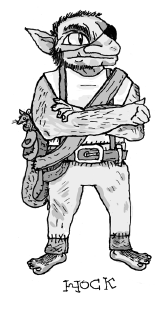
https://www.narrativedynamicspress....ngenerator.html
2/x
Original SA post Goblinville Gazette #1 2/x
After dealing with a monster, the goblins will probably want to make camp to rest, recuperate, and repair. They have to make camp every four turns or start suffering conditions - unless they have some grog to quaff!
The first requirement for making camp is a safe spot to set up in. Finding one, or getting back to a good one, might be risky, requiring an action roll.
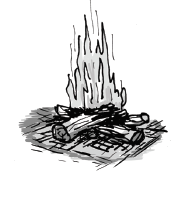
Once encamped, every goblin needs to eat a ration or suffer a condition. After that they can choose between sleep or undertaking a camp action (recover, repair, forage, or make supplies).
Sleep is good for your goblin. A ration and some sleep will remove the panicked and exhausted conditions. A goblin in worse shape, sick and/or injured can take the recover option. They will make an action roll (out of the normal marching order sequence) with the Danger of losing an inventory slot to a cool scar. They'll get their Action die, the Danger die, and can use a trait, title, or twist for more dice. On an Action die of 5-6 they clear their sick or injured track (not both !), on a 3-4 they reduce their condition to just exhausted or panicked as appropriate, and a 1-2 leaves them just as bad off as before making camp. The Danger of a scar resolves normally, on a 1-3 it happens.
Besides resting and healing, camp is an opportunity to work on their stuff. Repairing is an Action roll with a GM-assigned danger such as being exhausted from working all night, breaking a tool, or making noise.
If there might be food around, a goblin can forage. The results of this Action will vary depending on the current positioning of the group, but you aren't going to turn up a vast bounty of rations by poking around in the dark with a torch.
You can also make stuff, more torches for example. Running out of torches puts you in a bad position. Avoiding that is worth losing alittle sleep. Making up some rope or something else handy would be worth an extra die later on.
If the group is in real trouble they can camp twice in a row. Every goblin must eat another ration to get any benefit, and someone must keep watch as their camp action.
There has been a lot of references to conditions so far. I'd suggest that they should have come before monsters and making camp in the book. Of course, that would only be two ophysical pages earlier so it isn't a major sin to leave them until now.
There are five conditions:
Exhausted - can't invoke titles
Panicked - can't use traits
Sick - add 1d6 to your Action roll, lose the highest die
Injured - add 1d6 to your Action roll, lose the highest die
Dead - dead
If you suffer a condition you already have, an exhausted or panicked goblin marks sick or injured instead. A sick or injured goblin who suffers the same condition again dies.
And that's why you camp every four turns !
I'm going to finish this update with... Sorcery !
"Sorcery is the art of commanding pixies to perform acts that goblins cannot. Any goblin can learn sorcery. To cast a spell, they must fulfill three requirements:"
They know the spell - you can take a spell during character creation or learn them later.
They have the spell materials - losing your spell components is a good Danger. You can try and make more in camp or buy them from a witch, if your town has one.
They meet the spell's conditions - like with Iron Claw you have to keep staring at it.
Here's the spells in the book, these are barely cantrips by D&D terms.
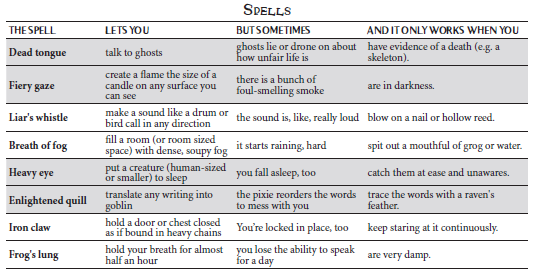
Casting spells is not an Action. If the conditions are met, the spell works. The Sorcery die (the one weird d6 you set aside when you started play) is rolled only to see what the spell cost the goblin. On a 6 they're fine, on a 3-5 the player marks a condition of their choice, and on a 1-2 they take Sick as a condition (and die if they're already Sick). You can add a Twist or risk running out of materials for an extra die, the possible Twists are in the "But Sometimes" column.
There's an optional rule for Wild Magic. If you want a risky or unconventional outcome from a spell, roll an Action with the Danger being proportionate to how unconventional the spell use is. Add in the Sorcery die and resolve the Action roll normally, with the sorcery outcome as an extra space to allot a die to.
Next up, Overland Travel !
And another sample goblin to tide you over until character creation.
You're a green-ear Witch wearing an iron mask. You experienced a trial by fire and then your boss fired you.
You are carrying 2 rations, 2 torches, some herbs, and a rat. You are wielding a sharpened stick.
3/x
Original SA post Goblinville Gazette #1 3/x
Welcome back to Goblinville ! We're done with the main rules. There are still the character creation, town, and GM chapters to get through.
Part One
Part two
I'm going to pull the rules for Grim Favor forward to the start of this installment and send Wilderness Travel to the back of the line. Grim Favor helps sets the tone for the whole game. Grim Favor is about how the Goblin Master resolves any uncertainty they have. If they're uncertain about which goblin something affects first or most, they look at the marching order. If they find themselves wondering "how favorable is this situation", then they look to Grim Favor, which is simply a d6 roll. Since the first session rules include setting aside a "weird" d6 as the Sorcery die, I'm going to suggest the GM set aside their Grim favor die at the start of the campaign. They can play with it during play as a sort of low-level existential threat to the goblins.
Resolving Grim Favor, on a 6 it's a "particularly favorable" situation, on a 3-5 the situation is indifferent, and on a 1-2 it's "particularly unfavorable". The 2:1 ratio between good and bad outcomes says a lot about what kind of play style the designers intended for Goblinville: good, old-fashioned, resource tracking, antagonistic GM play. I'm kind of surprised that there isn't a wandering monster table in here. Maybe in the next volume.
Death. This will probably come up a lot. This section paragraph covers goblin funerary rituals. Everyone says a few words and then loots one item off your body, everything else is left behind.
End of Session. At the end of the session every player decides if their goblin's outlook developed and if they achieved their goal. This involves the goblin telling their (brief) story about the adventure they just had. The rest of the group listens and comes up with a 1-4 word title. If all three of a goblin's title slots are filled, they advance. A goblin can also remove a trait, after which the group assigns them a new one. Taking the new one isn't completely mandatory, but it's advised that the goblin have a chance to help develop the new trait they're getting.
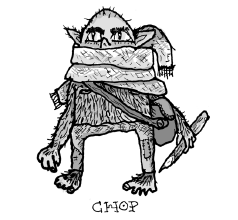
Advancement. This is tied to titles, if a goblin gains another title and already has all three filled in, they advance. After one advance they are a veteran and can recruit hirelings. After their second advance the goblin is now a boss, and roll Being a boss when in town instead of Going to work. Three advances makes the goblin a big boss; that's like a boss but they no longer pay for room and board, and can open a new location in town just by paying 40 scratch instead of having to play out finding a doctor and convincing her to hang out her shingle in your town. On their fourth advance, the goblin retires to a life of luxury and the player starts a new character.
Town. There is a basically placeholder paragraph here about stuff you can do in town, like buy stuff and work their jobs. In-town stuff gets a chapter later on.
Hirelings. Veteran goblins can hire other goblins to carry stuff and take risks on a journey. There's a die roll for telling a hireling to do something beyond being a porter or risking harm. They get paid 8 scratch up front, and 2 more when you return to town.
Overland travel. One of the longest sections of the rulebook, weighing at one whole page. These rules aren't set up for wandering around exploring stuff. The whole map is scary wilderness as far as your goblins are concerned. They will need a lead on an unexplored hex to even begin planning a trip. Hexes become explored when the goblins go there on purpose, just passing through doesn't count.
Once they have somewhere to go they will need to prepare. Supplies, mounts, and a map (bought or made) all improve their positioning for the trip. Compare the number of positive factors to the length of the trip to determine the group's position. On a one-day trip any one factor gives them good position, a whole week to the edge of the map and they need all three not to be in a bad position. A week is the limit for a single travel roll. Bad weather reduces their positioning, make a Grim Favor roll.
As usual, the goblin taking the lead makes the roll, or the first in marching order if no one seems to be taking charge. Success or progress get them so far depending on their position. There is a handy chart to suggest travel Dangers. Twists are possible but might derail the trip into an unplanned encounter and require starting a new journey from halfway out in the wilderness.
And that's the Playing the Game chapter. Next up is Characters, then Town, and finally the GM section.
4/x
Original SA post Goblinville Gazette #1 4/x
Part One
Part two
Part three
You, Goblins !
It’s time for the Characters chapter ! The players make their characters, and the group makes a start at defining the town and filling in the map.
Character creation is simple. Grab a sheet, a d6, and a d20. Each goblin does the first 7 steps by themselves, then it gets into group activities.
The first part of character creation has you rolling or choosing from 5 tables, choosing two trains, and a name.
First up is the goblin’s job. Roll a d20 or pick. The job gives you one item for your inventory; working for the witch gets you a unit of herbs, the trader gets you a pack, the woodcutter job grants a hatchet and so on. Your job gives you expertise which was discussed in an earlier update.
The age of the goblin; green-ear, roughneck, long tooth, or greybeard. This has no mechanical effect, it’s just character color.
Next you roll or pick your garb, you have one distinctive item of clothing or feature that your goblin is known for. A goat skull, striped pants, warpaint, eyepatch, goggle, and so forth. More color, but it goes in your inventory (more on that later).
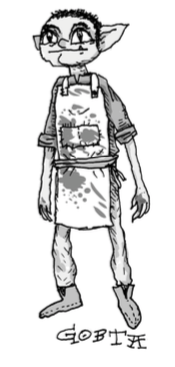
Name your boss and choose or roll whether they: died, fired you, went broke, ran off, got kidnapped, or got tossed in the brig.
Then you come up with one defining experience from your job and choose or roll for tone; personal insight, trial by fire, motivating loss, humbling failure, modest accomplishment, indebtedness to another goblin (ask who).
Next you choose one trait based on your appearance (small, hairy, extra green, etc.) and one trait based on your personality (nervous, loud, grumpy, etc.).
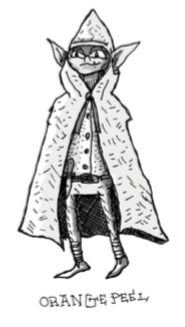
Lastly, you choose your goblin’s name (Hoggle, Creeper, Blix, etc.).
At this point the process shifts to group activities. Each of steps 8-13 is done by each player in turn before moving on to the next step.
At number 8, each goblin takes a turn telling the group the story of their experience and answering any questions about it. The rest of the group gives you a 1-4 word title to reflect the experience. The title must imply that something happened, good or bad, like Exile Witch, Friend to Thieves, or the Unburied.
Next, the goblins take turns introducing themselves, working out how they know each others and why it’s this group of friends or relatives going on adventures together.
Then the esteem trait is determined. The other goblins give you a trait based on what they think of your goblin and how you seem. Sagacious, Quarrelsome, and Reliable are the examples given. Traits and titles can be invoked once per session to grant an extra die for an action roll.
Everybody then takes a turn deciding their goblin’s outlook; how they see the world, what they think of running into monsters, or other dangers, how they feel about their crappy job.
Now it’s the GM’s turn on the spot. The goblins get a round of questions for the GM, like what happened to their missing boss, where there might be treasure. The GM uses the questions to come up with an opportunity, and should definitely make note of what the goblins are interested in.
Lastly in the group phase everyone writes a goal for the session (don’t die, get rich, find their boss, change jobs, and so on).
Everyone then picks out some equipment and a weapon. the weapon choices are pretty basic for a starting goblin; club, staff, rusty knife, broken bottle, sharp stick, sling and stones. You all get some basic stuff, everyone will have 2 torches, 2 rations, and a full skin of grog. You also get a satchel (5 inventory slots) to put your stuff in.
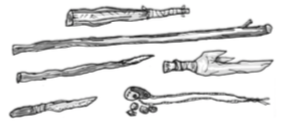
You can choose or roll one more thing; 20 feet of rope, a small hammer, useful herbs, a rat, a spell and its components, or a burlap sack indicating optimism about finding more stuff soon ! If you got a spell, you have to roll to see which one.
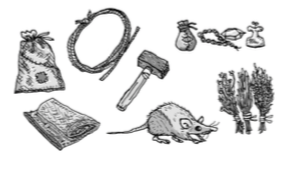
The goblins are ready to go adventuring, there’s just a little left to do to fill in the world first.
On the town sheet, mark each goblin’s base location from their job. The GM chooses or rolls one more location to be open at the start of play. On the wider world map, put Goblinville itself near the center of the map in terrain based on which starting jobs are in play. Each player gets to choose one hex adjacent to town and decide the main terrain type for that hex (forest, river, tundra, jungle, etc.). Choose one hex and draw a road starting from town.
That completes preparation for play, the GM and the goblins are ready for adventure !
The You, Goblins ! chapter also has a discussion of inventory, which is important in the game. You have to decide where you’re carrying everything you have. You get slots for head, neck, your hands, feet, torso, belt, and pockets. Satchels, packs, and sacks take up one or two torso slots but let you carry much more stuff than you would otherwise.
And lastly, some player advice:
Get the most out of playing a goblin!
Keep in mind your goal and outlook. Pursue it, be obvious. Ham it up.
Respond to the other goblins' outlook. Say what you think of it.
Don’t push for rolls, push for outcomes. Trust the GM to call for a roll when there’s danger.
Try to come up with a clever solution to a problem. It might not require a roll.
Use your traits. Describe your key features and find ways they are useful.
Invoke your titles when you think they're appropriate. You'll earn more later.
Create Twists that bring the kind of trouble you're interested in.
Next up, the Town chapter !
5/6
Original SA post Goblinville Gazette #1 5/6

Part One
Part two
Part three
Part four
We’re almost done with Goblinville, and in this installment were looking at the ‘ville itself. It’s the Town chapter !
Mechanically, this chapter does a lot of the heavy lifting, and it’s got one of the cleverest parts of a game system that I already think is pretty damn clever. That’s the equipment listing, and I’m going to to dive right in and post it. first
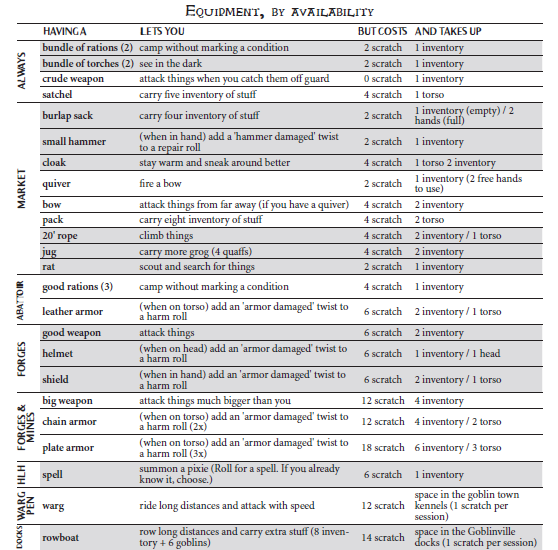
Across the top you have the usual name, cost, and weight or inventory space. Goblinville adds in the “Lets you” column which give you the mechanics for every item in the game. Down the left items are grouped by availability; if there isn’t an active location for the items you want, you can’t buy them yet. But you can go out and recruit someone or find the stuff needed for someone to set up shop.
That’s really beautiful from a utilitarian perspective. You get the mechanics for your stuff and adventure hooks all in one handy table. And there's also everyone's favorite for your successful adventurer looking to retire:

Locations in town have another adventure hook. The keystone for a location is a special item, formula, or something else that makes for a good quest. Once you have secured the keystone for a location, it adds a special benefit. For example if you have obtained the keystone for the Latrines location (and I have no idea what it would be), you ignore Disease crises when rolling for bad things to happen in town.
Cool stuff dealt with, there’s also rules for what to do when your goblins get back to town after an adventure.
First off, the GM makes a Grim Favor roll to see what's going on; this is modified by the current number of crises in play. No crises, roll 2d6 and take the highest, one roll 1d6, and if there are multiple crises roll 2d6 and take the lowest die. On a 1-2 the situation is catastrophic, on a 3-5 things are precarious, and only on a 6 are things going well. Naturally it's up to the players to solve crises and set things right. There are 4 kinds of crises; Monsters, War, Disease, and Famine. And there are three tables to roll on, one each fro catastrophe, precarious, and boon.
The boon table has the good stuff; rumors of a keystone, a new boss moves in, rumors to a good treasure, or cheap room & board. IN a precarious situation the GM can roll monsters or disease for crises, scarcity to make goods more expensive, or a boss disappears or a keystone vanishes. A catastrophe has a chance for famine or war, a boss dies, a keystone is destroyed, or your run of the mill breakdown of society.
Some of those are direct adventure hooks like rumors of treasure or "go find Boss Urgh so the forge can re-open". For the rest, the GM gets an ongoing avalanche of events to keep the players busy.

After the GM ruins everyone's day, the rules suggest pooling the goblins' scratch and having one player keep track of spending. That might work. Then everyone needs to spend 2 scratch for room & board or mark a condition from sleeping rough. Then everyone has to go back to work ! Work is an Action roll with the Danger of having to mark a condition, no OSHA in Goblinville. Wages are 1 scratch, so without adventuring income, sleeping under a roof is a luxury. No wonder the PCs have gone adventuring !
The goblins can spread a little scratch around to look for an opportunity if nothing else has presented itself. The GM uses what kind of lead they went after, which is location based, as a seed for the next adventure.
After that, they have a chance to hire help like guides, camp guards, and heavies (aka muscle). These goons aren't as flexible as an actual hireling who might take a risk for you, but they'll be some help.
And then the Town cycle is complete, roll for marching order and set off into the wilderness again. Hopefully they have some idea where they're going.

The chapter goes on to dealing with Locations in detail, how to open up a new location, keystones, and two pages of stuff like this about each location:
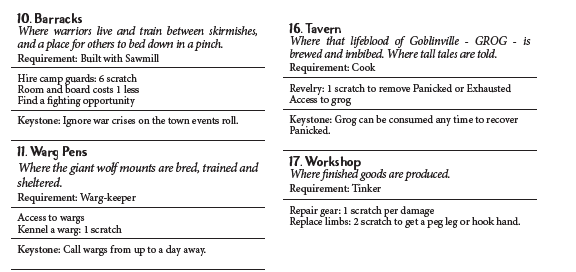
Next up is the final installment ! The GM chapter and sample adventure.
6/6
Original SA post Goblinville Gazette #1 6/6
We're done !
This entry is for the GM chapter and sample adventure for Goblinville.
The heart of the chapter is about creating opportunities; specifically about how to hook the goblins into a dungeon crawl. The book suggests that one-page dungeons are great for GV, and I think they're right. You can find endless sources of small dungeons by goodling "one page dungeon" and looking at the Images results.
Populating your map appropriately gets a few paragraphs. Money is more abstracted in GV than in other games, so 1 scratch = 5 gold pieces in most existing adventures. Monsters will drop roughly one scratch worth of stuff per move they have. Monsters should have 2-8 moves, and there's a reminder that the goblins are technically also monsters and might be able to get along with some of the dungeon denizens they encounter.
There are tables to roll types of work for an opportunity, what the boss wants, interesting dangers, and curses. These will help the GM come up with opportunities and complications. It's a short section, but useful.
I like the discussion of traps. The rules break down traps into "obvious but sudden" or "hidden but slow". Traps are suggested to be opportunities for problem solving, not punishments for not pixel bitching the dungeon.
That's about a page and a half worth of the chapter. The chapter starts off with a review of the first session for about half a page:
Goblin creation
Introductions
Listening to what the players are talking about
Opportunity. One should become apparent from the table talk, otherwise roll one and add it to the conversation.
Finishing touches.
Embark ! Roll for initiative !
This is similar to starting with a blank map as in PbtA games like Dungeon World, with more focus provided by the Opportunity and Boss Offering The Work tables.
After the Opportunity material previously discussed, we get half a page on running the game and half a page on creating monsters.
The material on running the game should be familiar to any RPG veteran, it's just principles and such, tuned for the GV system:
Throw the goblins into danger
Help them engage with the fictional situation
Dont skip over problem-solving by rushing to the roll.
Dig into their traits and titles
Give detail and context to each roll.
And then Monsters ! A monster in GV is a collection of moves. Some provide flavor, some describe their tactics, some are attacks, and some monsters have finishing moves to take down an unlucky goblin. Lizardmen have Hiss, Hide, Ambush, and Disarm. No finishing moves on the list, but if they outnumber the goblins they'll gain armor (or the monster might actually be armored). Successes on an action roll cross off a monster move, armor first. So when Lizardmen show up the GM can lead with a Hiss to set up the situation or go straight to Ambush if they want real danger from the start of the encounter.
A carrion crawler is an old GM favorite. They have Skulk, Pin, Feed, and Paralyzing Bite. The bite is a finishing move, if it uses it on a goblin that goblin is down and out. Not dead in this case, but you'll have to camp and let them recover before they can do anything.
There are a total of 15 monsters detailed on the monster page. It's mostly low level stuff and dungeon classics like kobolds (known as Dogbrothers), centipedes, gelatinous cubes, giant rats, bats, and with gnolls and a Minotaur as serious opposition. With the rules for statting out your own monsters a GM is pretty well provided with critters to populate a dungeon.
The chapter ends with a 5-page, 5 room dungeon called the Pit of Mirrors. The sample adventure for any RPG is an important means of communicating how to play the actual game as intended. The adventure starts with this section:
Tips for Running The Pit of Mirrors
Read this entire chapter so you know the full
picture of what's going on. Read it a few
times. It's short!
Use your own words. When describing what
the goblins see in each room, try not to
just read our description off the page.
Nothing screams "railroad!" like reading
dungeon text verbatim. Make eye contact;
use your hands.
The weavers and the adventurers have
their own agendas. They're not just there
as obstacles to kill. Play to their desires
and instincts and the goblins will react
accordingly.
Use the timeline! Every time the players
reroll initiative, something happens in the
background. This helps you keep things
moving.
Avoid the instinct to "make it hard". The
adventure is plenty hard on it's own. The
action roll mechanics and the dungeon
layout rules create the challenge. It's not
on you to add more– it's on you to make it
exciting and interesting.
I'm bolding important bits. "Use your own words" cannot be emphasized enough for any GM running a published module. The references to agendas and the timeline are good reminders that the goblins aren't just kicking in doors in a static scenario. Some of the NPCs have their own plans, and the timeline tracks progress of the plot much like a PbtA Front.
There are a few paragraphs of what the goblins know when they set out, and what they can discover on-site. This section also fills in the GM on what's going on and how the goblins can interact with the situation as they find it.
Getting to the Temple. The adventure doesn't just say to use the overland travel rules and leave it at that. It gives the duration, 3 days through jungle, and defines the group's position, sets up the Action roll for travel and tells the GM what the first scene should be based on how well the roll goes. I like this, this really helps get the adventure started.
Each room in the dungeon has it's own dangers, monsters, loot, and a sketch map to add detail to the description given. Again, I love the art style in this book, doubly so on the maps.
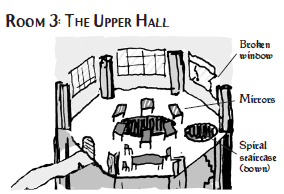
And then there's the timeline. This one starts at turn 2 and goes to turn 8. If they players don't succeed, bad things happen. There are plenty of ways given to upset the impending doom but they goblins will need to be rpoactive. Every time they complete a turn, the timeline advances so they can't just faff about and hope. Again, the timeline works like a PbtA Front but with more detail and a much more implacable clock. This is why the GM is advised to not try and "make it hard", the adventure already is hard and there are consequences for failure.
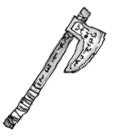
And that's Goblinville Gazette #1 !
I have to say I'm impressed with what's been done in a 32 page booklet. This is a solid, rules-light RPG with a unique system that tries (and succeeds) to capture the classic style dungeon crawl with its own twist and modern sensibilities. The production values are high; the layout is very well done and who can hate the charming artwork ?
This would be an excellent game for a one-shot or short campaign. For only
 for screen and print PDFs it's a steal. But buy it anyway.
for screen and print PDFs it's a steal. But buy it anyway.https://www.drivethrurpg.com/produc...--Rules-of-Play